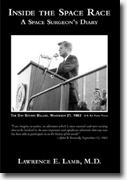Inside the Space Race
Lawrence E. Lamb, MD
book reviews:
· general fiction
· chick lit/romance
· sci-fi/fantasy
· graphic novels
· nonfiction
· audio books
· author interviews
· children's books @
curledupkids.com
· DVD reviews @
curledupdvd.com
newsletter
win books
buy online
links
home
for authors
& publishers
for reviewers

 |
Inside the Space Race: A Space Surgeon's Diary Lawrence E. Lamb, MD Synergy Books Hardcover 428 pages November 2006 |
|
Tom Wolfe’s book and the ensuing movie The Right Stuff relayed the grueling and sometimes bizarre medical tests that were performed on the men vying for selection as America’s first astronauts. Supposedly, because of the astronauts’ complaints and other various reasons, subsequent astronaut medical evaluations were moved from a private clinic in Albuquerque, New Mexico to the Air Force’s School of Aerospace Medicine in San Antonio, Texas.
The book provides a history of events that precipitated the space race between the U.S. and the Soviet Union, as well as Lamb’s personal story of how he came from a poor family to become a respected doctor. Lamb also offers a behind-the-scenes look at NASA and the U.S. political forces in the 1960s. A major part of the book details Lamb’s diagnosis of atrial fibrillation in Deke Slayton, one of the original Mercury astronauts. Since this disqualified Slayton from flying in space, the diagnosis was met with much resistance from Slayton and many people within NASA. NASA tried to downplay the diagnosis and, to no avail, tried to find other doctors who would disagree with Lamb’s analysis. Another major theme in the book is the petty, and sometimes consequential, conflicts between military personnel, and between the Department of Defense, the Air Force’s School of Aerospace Medicine, and the Manned Spaceflight Center (which later became Johnson Space Center in Houston). Everyone was vying to become leaders in the new and important space sector. Dr. Lamb also shares his relationship with Lyndon Johnson, as both his doctor and friend. At Lamb’s urging, Vice President Johnson and President John Kennedy visited the School of Aerospace Medicine, as fate would have it, on the day before Kennedy was killed. While Inside the Space Race Another annoyance is Lamb’s constant reference to NASA’s effort to rocket a human into earth orbit, and then to the moon, as the “man-in-space program.” There are instances of this exact term being used several times in one paragraph. He could have mixed it up with other ways of saying it, such as “manned spaceflight” or just the “space program.” Of course today, NASA calls it “human spaceflight.” Lamb’s manner throughout the book displays the paranoia that Americans felt about the Soviet Union, and one wonders if he has ever gotten past the mistrust and suspicions of the Cold War, even though the U.S. and Russia have now long been partners in space exploration. Lamb never describes the processes in which he and the other members of the staff at The School determined which medical tests were effective, or which ones were ultimately used to cull the astronaut corps. Perhaps this information is classified, but it would be interesting to know if the tests portrayed in The Right Stuff were accurate or just dramatic license. Lamb does discuss some of the tests they conducted to learn about the effects of weightlessness, and talks about the importance of electrocardiograms and how his desire to test patients while they were exercising aided in the development of the attachable electrode sensors. Despite the annoyances, the book held my attention and is an interesting, inside account of an important time in United States history. It includes many unique photographs, copies of letters and documents, and an appendix of documentation for the Slayton diagnosis. Originally published on Curled Up With A Good Book at www.curledup.com. © Nancy Atkinson, 2007 |
|
|
|
 Click here to learn more about this month's sponsor! |
|
| fiction · sf/f · comic books · nonfiction · audio newsletter · free book contest · buy books online review index · links · · authors & publishers reviewers |
|
| site by ELBO Computing Resources, Inc. | |
 Cardiologist Lawrence Lamb was on staff at “The School,” as he affectionately calls it, and his involvement in the space race occurred by being in the right place at the right time. “I just happened to be sitting on the rocket when the fuse was lit,” he says. Lamb details his participation with NASA in his book,
Cardiologist Lawrence Lamb was on staff at “The School,” as he affectionately calls it, and his involvement in the space race occurred by being in the right place at the right time. “I just happened to be sitting on the rocket when the fuse was lit,” he says. Lamb details his participation with NASA in his book,